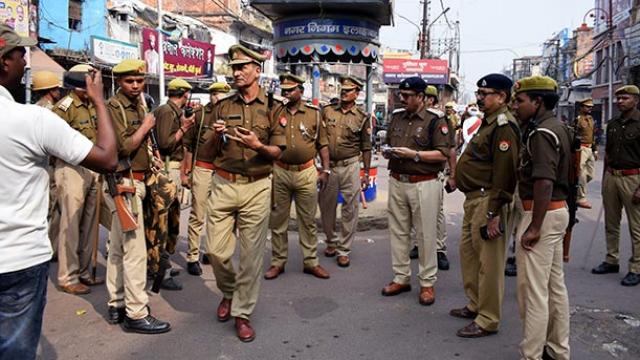Ayodhya: Security arrangements in Ayodhya have been strengthened ahead of the anniversary of the Babri Masjid demolition December 6, a top official said today.
Security around Ramjanmabhoomi, which falls in the ‘red zone’ high-security area, has been stepped up and other landmark religious sites around it are also under tight vigil, Ayodhya DM Anuj Jha said.
“We had kept a hawk-eye vigil across the temple town and other parts of the district till the verdict, and security will remain intensified till the Babri (Masjid) demolition anniversary,” he said.
“Our next challenge would be to maintain calm, peace and harmony on December 6, though I am positive that people of Ayodhya will display utmost maturity as they are peace-loving,” Jha said.
The Ayodhya security cover has four zones — red zone for the 2.77 acres disputed site, yellow zone for the city, green zone for the district and blue zone for the neighbouring areas of the district.
Streets in red zone areas and those leading to the zone are being kept under tight watch and barricades in these places which were put up ahead of the verdict will continue to be there till December 6, the District Magistrate said.
A week after the Supreme Court’s verdict in the communally sensitive Ayodhya land dispute case, vigil around important religious sites such as Hanuman Garhi, Kanak Bhawan and Ram ki Paidi remained heightened on Saturday and security personnel also guarded important public places.
A high alert remained around the Ramjanmabhoomi site even as thousands of devotees streamed in to pay obeisance to Lord Ram.
The Ayodhya district magistrate also said Section 144 clamped on November 8 will remain in place till December 28. The section prohibits unlawful assembly of four or more people.
Jha asserted that people of Ayodhya have “very peacefully and maturely reacted” to the Supreme Court verdict as “expected” by the administration.
“If people outside can take the message of Ayodhya, nothing untoward will happen anywhere else in the country in the wake of the judgement,” he added.
Settling a fractious issue that goes back more than a century, the Supreme Court in a historic verdict November 9 backed the construction of a Ram temple by a trust at the disputed site in Ayodhya, and ruled that an alternative five-acre plot must be found for a mosque in the Hindu holy town.
Amid heightened security, members of the Muslim community on Friday offered prayers at various mosques in Ayodhya district, the first ‘jumma namaz’ after the landmark verdict.
“Friday namaz was offered by people at various mosques in Ayodhya district. Security was stepped up at all mosques for the day, including in rural areas.
“We had also alerted our officers at ground level to immediately report any protest, such as sporting of black arm bands by anyone. Everything went off peacefully,” Jha said.
Security forces have been keeping a hawk-eye vigil over the holy town since the evening of November 8, a day before the judgement was announced, even as a security apparatus was put in place days before in anticipation of the SC’s decision.
A posse of security personnel have been deployed through out the holy town since November 8. Regular check-posts set up in the streets have remained in place, alongside patrolling parties on roads which intensified vigil at night.
Police officials have been keeping tight vigil on social media too to trace any inflammatory statements or posts.
Besides, 45 CCTV cameras recently installed around important sites such as Hanuman Garhi, Kanak Bhawan, Dashrath Mahal and Ram ki Paidi are being fed to a centralised control room and monitored by Ayodhya SSP to spot if anyone “attempts any mischief”, Jha said.
Ahead of the verdict, lakhs of devotees visited the pilgrimage town for 14 Kosi and 5 Kosi Yatras. On the auspicious Hindu occasion of Kartik Purnima November 12, over five lakh pilgrims converged in the city.
“It all went off peacefully as we had made adequate preparations,” Jha said.
“Schools and colleges reopened from November 13 in Ayodhya and in some areas we have removed barriers that impeded movement of children and in other areas we have made it a bit easier to navigate while keeping overall security in mind,” Jha said.
December 6, 1992, a frenzied army of kar sewaks had demolished the historic Babri Masjid that was built in 1528 by Mughal emperor Babur.
A large section of Hindus and right-wing outfits believe that the mosque was built by destroying a Ram temple that stood on the birthplace of Lord Ram, a claim rejected by Muslims.
The mosque’s demolition had triggered unrest in Ayodhya in 1992 and communal riots in various parts of the country.
Right-wing outfits Vishwa Hindu Parishad (VHP) and Bajrang Dal celebrate December 6 as ‘Shaurya Diwas’ (glory day) while Muslim organisations mark it as ‘Yaum e Gam’ (day of sorrow).
PTI







































